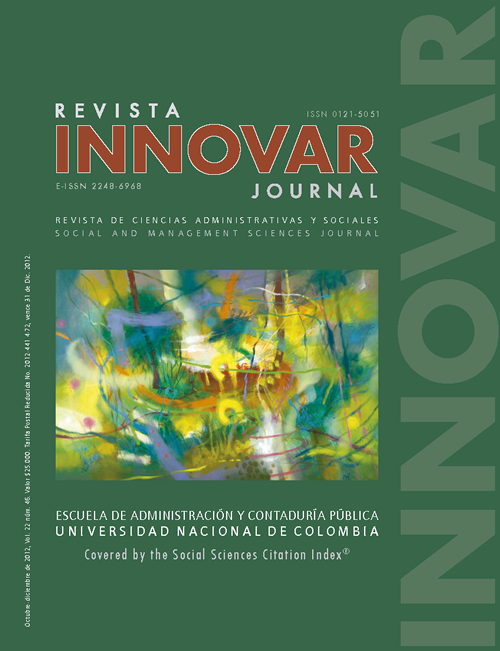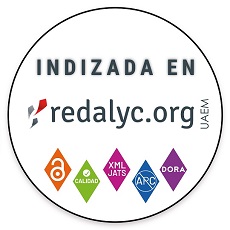The impact of business group diversification on emerging market multinationals: Evidence from Latin America
Impacto de los grupos empresariales diversificados en las multinacionales de mercados emergentes: Evidencia de América Latina
Impacto dos grupos empresariais diversificados nas multinacionais de mercados emergentes: evidência da américa latina
Palabras clave:
Internationalization, performance, business groups, institutional voids, regionalization (en)Internacionalización, performance, grupos empresariales, fallas institucionales y regionalización (es)
internacionalização, performance, grupos empresariais, falhas institucionais e regionalização (pt)
Descargas
Referencias
Aiken, L. & West, S. (1991). Multiple Regression: Testing and Interpreting Interactions. Newbury Park, CA: Sage.
Aulakh, P., Kotabe, M. & Teegen, H. (2000). Export strategies and performance of firms from emerging economies: Evidence from Brazil, Chile, and Mexico. Academy of Management Journal, 43(3), 342-361.
Baum, C. (2006). An Introduction to Modern Econometrics Using Stata. College Station, TX: Stata Press.
Baum, J. A. & Shipilov, A. V. (2006). Ecological approaches to organizations. In Clegg, S. R., Hardy, C., Nord, W. & Lawrence, T. (Eds.), Handbook of organization studies: 55-110. London: Sage.
Bausch, A. & Krist, M. (2007). The effect of context-related moderators on the internationalization-performance relationship: Evidence from meta-analysis. Management International Review, 47(3), 319-347.
Berry, H., Guillen, M. F. & Zhou, N. (2010). An institutional approach to cross-national distance. Journal of International Business Studies, 41, 1460-1480.
Bonaglia, F., Goldstein, A. & Mathews, J. A. (2007). Accelerated internationalization by emerging markets multinationals: The case of the white goods sector. Journal of World Business, 42(4), 369-383.
Brenes, E. (2000). Strategies for globalizing Latin American business. Journal of Business Research, 50(1), 3-7.
Brenes, E. & Dominguez, L. (1997). Strategic choices in the new international enterprise in Latin America. Journal of Business Research, 38(1), 1-2.
Burt, R. S. (1992). Structural Holes: The social structure of competition. Harvard University Press.
Carney, M., Gedajlovic, E. R., Heugens, P. P., Van Essen, M. & Van Oosterhout, J. (2011). Business group affiliation, performance, context and strategy: A meta analysis. Academy of Management Journal, 54(3).
Chakrabarti, A., Vidal, E. & Mitchell, W. (2011). Business transformation in heterogeneous environments: The impact of market development and firm strength on retrenchment and growth reconfiguration. Global Strategy Journal, 1, 6-26.
Chung, C. (2001). Markets, culture and institutions: The emergence of large business groups in Taiwan, 1950s-1970s. Journal of Management Studies, 38(5), 719-745.
Contractor, F., Kundu, S. & Hsu, C. (2003). A three-stage theory of international expansion: The link between multinationality and performance in the service sector. Journal of International Business Studies, 34(1), 5-18.
Cuervo-Cazurra, A. (2007). Sequence of value-added activities in the internationalization of developing country MNEs. Journal of International Management, 13(3), 258-277.
Cuervo-Cazurra, A. (2008). The multinationalization of developing country MNEs: the case of multilatinas. Journal of International Management, 14(2), 138-154.
Cuervo-Cazurra, A. & Dao, L. (2009a). Structural reform and firm exports. Management International Review, 49(4), 479-507.
Cuervo-Cazurra, A. & Dao, L. (2009b). Promarket reforms and firm profitability in developing countries. Academy of Management Journal, 52(6), 1348-1368.
Cuervo-Cazurra, A. & Genc, M. E. (2008). Transforming disadvantages into advantages: developing country MNEs in the least developed countries. Journal of international business studies, 39, 957-979.
Cuervo-Cazurra, A. & Genc, M. E. (2011). Obligating, Pressuring, and Supporting Dimensions of the Environment and the Non-Market Advantages of Developing-Country Multinational Companies. Journal of Management Studies, 48(2), 441-455.
De Soto, H. (2000). The Mystery of Capital: Why Capitalism Triumphs in the West and Fails Everywhere Else. New York: Basic Books.
Dierickx, I. & Cool, K. (1989). Asset stock Accumulation and sustainability of competitive advantage. Management Science, 35(12), 1504-1514.
DiMaggio, P. J. & Powell, W. W. (1983). The iron cage revisited - Institutional isomorphism and collective rationality in organizational fields. American Sociological Association, 48(2), 147-160.
Flores, R. G. & Aguilera, R. V. (2007). Globalization and location choice: an analysis of US multinational firms in 1980 and 2000. Journal of International Business Studies, 38(7), 1187-1210.
Garcia-Canal, E. & Guillen, M. F. (2008). Risk and the strategy of foreign location choice in regulated industries. Strategic Management Journal, 29, 1097-1115.
Ghemawat, P. & Khanna, T. (1998). The nature of diversified business groups: A research design and two case studies. Journal of industrial economics, 46(1), 35-61.
Glaum, M. & Oesterle, M. J. (2007). 40 Years of Research on Internationalization and Firm Performance: More Questions than Answers? Management International Review, 47(3), 307-317.
Goerzen, A. & Beamish, P. (2003). Geographic scope and multinational enterprise performance. Strategic Management Journal, 24(13), 1289-1306.
Gomes, L. & Ramaswamy, K. (1999). An empirical examination of the form of the relationship between multinationality and performance. Journal of International Business Studies, 30(1), 173-188.
Gomez-Mejia, L. R., Balkin, D. B. & Cardy, R. L. (2012). Managing human resources. Upper Saddle River, NJ: Prentice Hall.
Granovetter, M. (1994). Business groups. In Smelser, N. J. & Swedberg, R. (Eds.) The Handbook of Economic Sociology (pp. 453-475). Princeton, NY: Princeton University Press.
Granovetter, M. (2005). Business group and social organization. In Smelser, N. J. & Swedberg, R., (Eds.), The Handbook of Economic Sociology. Princeton, NY: Princeton University Press.
Guillen, M. (2000). Business groups in emerging economies: A resourcebased view. Academy of Management Journal, 43(3), 362-380.
Guillen, M. (2002). Imitation, inertia and foreign expansion: South Korean firms and business groups in China, 1987-1995. Academy of Management Journal, 45(3), 509-525.
Guillen, M. (2003). Experience, imitation, and the sequence of foreign entry: wholly owned and joint-venture manufacturing by South Korean firms and business groups in China, 1987-1995. Journal of International Business Studies, 34(2), 185-198.
Gwartney, J., Lawson, R. & Hall, J. (2011). Economic Freedom of the World: 2011 Annual Report. Fraser institute. http://www.freetheworld.com/2011/reports/world/EFW2011_complete.pdf (September 15, 2011).
Haar, J. (1989). A comparative analysis of the profitability performance of the largest US, European and Japanese multinational enterprises. Management International Review, 29(3), 5-18.
Hair, J. F., Anderson, R. F., Tatham, R. L. & Black, W. C. (1998). Multivariate data analysis. Upper Saddle River, NJ: Prentice Hall.
Hannan, M. T. & Freeman, J. (1984). Structural inertia and organizational change. American Sociological Review, 49(2), 149-164.
Henisz, W. J. (2003). The power of the Buckley and Casson thesis: The ability to manage institutional idiosyncrasies. Journal of international business studies, 34, 173-184.
Hennart, J. F. (2007). The theoretical rationale for a multinationality-performance relationship. Management International Review, 47(3), 423-452.
Hennart, J. F. (2011). A theoretical assessment of the empirical literature on the impact of multinationality on performance. Global Strategy Journal, 1(1), 135-151.
Holburn, G. L. F. (2001). Regulatory Institutions and Firm Strategy: Theory and Evidence from the Electric Power Industry. Unpublished doctoral dissertation, University of California, Berkeley.
Holburn, G.L. & Zelner, B.A. (2010). Political Capabilities, Policy Risk, and international investment strategy from the global electric power generation industry. Strategic Management Journal, 31(12), 1290-1315.
Hoskisson, R.E., Cannella, A.A., Tihanyi, L. & Faraci, R. (2004). Asset restructuring and business group affiliation in French civil law countries. Strategic Management Journal, 25(6), 525-539.
Hoskisson, R. E., Eden, L., Lau, C. M. & Wright, M. (2000). Strategy in emerging economies. Academy of Management Journal, 43(3), 249-267.
Hoskisson, R. E., Johnson, R. A., Tihanyi, L. & White, R. E. (2005). Diversified business groups and corporate refocusing in emerging economies. Journal of Management, 31(6), 941-965.
Hundley, G., Jacobson, C. K., (1998). The effects of the keiretsu on the export performance of Japanese companies: Help or Hindrance? Strategic Management Journal, 19(10), 927-937.
Khanna, T. & Palepu, K. (1997). Why focused strategies may be wrong for emerging markets. Harvard Business Review, 75(4), 41-51.
Khanna, T. & Palepu, K. (1999). The right way to restructure conglomerates in emerging markets. Harvard Business Review, 77(4), 125-134.
Khanna, T. & Palepu, K. (2000a). The future of business groups in emerging markets: Long-run evidence from Chile. Academy of Management Journal, 43(3), 268-285.
Khanna, T. & Palepu, K. (2000b). Is group affiliation profitable in emerging markets? An analysis of diversified Indian business groups. The Journal of Finance, 14(2), 867-891.
Khanna, T. & Rivkin, J. W. (2001). Estimating the performance effects of business groups in emerging markets. Strategic Management Journal, 22(1), 45-74.
Kim, H., Hoskisson, R. E. & Wan, W. P. (2004). Power dependence, diversification strategy and performance in keiretsu member firms. Strategic Management Journal, 25(7), 613-636.
Kostova, T. & Zaheer, S. (1999). Organizational legitimacy under conditions of complexity: The case of the multinational enterprise. Academy of Management Review, 24(1), 64-81.
La Porta, R., Lopez de Silanes, F., Shleifer, A. & Vishny, R. W. (1997). Legal determinants of external finance. The journal of finance, 52(3), 1131-1150.
Mathews, J. A. (2006). Dragon multinationals: New players in 21st century globalization. Asia Pacific Journal of Management, 23(1), 5-27.
Meyer, K. E. (2006). Global focusing: from domestic conglomerates to global specialists. Journal of Management Studies, 43(5), 1109-1144.
North, D. (1990). Institutions, institutional change and economic performance. New York: Cambridge University Press.
OUSTR - Office of the United States Trade Representative (2012). Free Trade Agreements. Disponible en from: http://www.ustr.gov/ trade-agreements/free-trade-agreements.
Peng, M. W. (2003). Institutional transitions and strategic choices. Academy of Management Review, 28(2), 275-296.
Peng, M. W., Lee, S. & Wang, D. (2005). What determines the scope of the firm over time? A focus on institutional relatedness. Academy of Management Review, 30(3), 622-633.
Prahalad, C. K. & Bettis, R. A. (1986). The dominant logic - A new linkage between diversity and performance. Strategic Management Journal, 7(6), 485-501.
Rugman, A. & Verbeke, A. (2004). A perspective on regional and global strategies of multinational enterprises. Journal of International Business Studies, 35(1), 3-18.
Rugman, A. & Verbeke, A. (2005). Towards a theory of regional multinationals: A transaction cost economics approach. Management International Review, 45(1), 5-17.
Rugman, A. & Verbeke, A. (2007). Liabilities of regional foreignness and the use of firm-level versus country-level data: a response to Dunning et al., (2007). Journal of International Business Studies, 38(1), 200-205.
Rugman, A. & Verbeke, A. (2008a). A New Perspective on the Regional and Global Strategies of Multinational Services Firms. Management International Review, 48(4), 397-411.
Rugman, A. & Verbeke, A. (2008b). The theory and practice of regional strategy: A response to Osegowitsch and Sammartino. Journal of International Business Studies, 39, 326-332.
Rugman, A., Verbeke, A. & Nguyen. (2011). Fifty years of International business theory and beyond. Management International Review, 51, 755-786.
Shleifer, A. & Vishny, R. (1997). A survey of corporate governance. Journal of Finance, 52, 737-783.
StataCorp. (2005). Stata Statistical Software: Release 9.0. College station, TX: StataCorp LP.
Tan, D. & Meyer, K. (2010). Business groups' outward FDI: A managerial resources perspective. Journal of International Management, 16(2), 154-164.
Thomas, L. G. & D'Aveni, R. A. (2010). The rise of hypercompetition from 1950 to 2002: Evidence of increasing industry destabilization and temporary competitive advantage. Working paper 2004-11. Hanover, NH: Tuck School of Business at Darmouth.
Tihanyi, L., Griffith, D. A. & Russell, C. J. (2005). The effect of cultural distance on entry mode choice, international diversification, and MNE performance: a meta-analysis. Journal of International Business Studies, 36, 270-283.
USA Today. (2003). 39 million make Hispanics largest U.S. minority group. Disponible en: http://www.usatoday.com/news/nation/census/2003-06-18-Census_x.htm. (05 January 2012).
Vassolo, R. S., De Castro, J. O., Gomez-Mejia, L. R. (2011). Managing in Latin America: Common issues and research agenda. The Academy of Management Perspectives, 25(4), 22-36.
Vermeulen, F. & Barkema, H. (2002). Pace, Rhythm, and Scope: Process Dependence in Building a Profitable Multinational Corporation. Strategic Management Journal, 23(7), 637-653.
Verbeke, A., Li, L. & Goerzen, A. (2009). Toward more effective research on the multinationality-performance relationship. Management International Review, 49(2), 149-162.
Williamson J. (2004). The strange history of the Washington consensus. Journal of Post Keynesian Economics, 27, 195-206.
Wooldridge, J. (2002). Econometric Analysis of Cross Section and Panel Data. Cambridge, MA: MIT Press.
Yiu, D., Lu, Y., Bruton, G. D. & Hoskisson, R. E. (2007). Business groups: An integrated model to focus future research. Journal of Management Studies, 44(8), 1551-1579.
Cómo citar
APA
ACM
ACS
ABNT
Chicago
Harvard
IEEE
MLA
Turabian
Vancouver
Descargar cita
Visitas a la página del resumen del artículo
Descargas
Licencia
Derechos de autor 2012 Innovar

Esta obra está bajo una licencia internacional Creative Commons Reconocimiento-NoComercial-CompartirIgual 3.0.
Todos los artículos publicados por Innovar se encuentran disponibles globalmente con acceso abierto y licenciados bajo los términos de Creative Commons Atribución-No_Comercial-Sin_Derivadas 4.0 Internacional (CC BY-NC-ND 4.0).
Una vez seleccionados los artículos para un número, y antes de iniciar la etapa de cuidado y producción editorial, los autores deben firmar una cesión de derechos patrimoniales de su obra. Innovar se ciñe a las normas colombianas en materia de derechos de autor.
El material de esta revista puede ser reproducido o citado con carácter académico, citando la fuente.
Esta obra está bajo una Licencia Creative Commons:





















